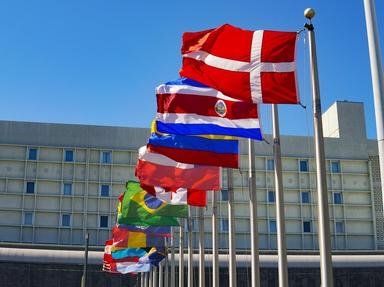Quiz Answer Key and Fun Facts
1. Pictured is the flag of Sweden.
1. Change the field colour to red.
2. Change the cross color to dark blue
3. Make the blue cross thinner leaving a larger white cross surrounding the new blue cross
To which country does this new red flag belong?
2. Here is the Estonian flag. The tri-band is common to national flags but the colour combination is not.
1.Swap the position of the white and black bands
2. Make the white band half as wide as it as it is now.
3. Make the other two bands wider to accommodate the smaller white band
4. Change the black and blue bands to a dark red
What national flag have you just created?
3. A simple flag: the two-banded Ukrainian flag.
1. Squash the blue and yellow bands down a bit to add a white band
2. Make sure the three bands are of equal height
3. Change the yellow band to red
What country owns this new flag?
4. The flag of Nicaragua.
1 Remove the coat of arms
2. Change the white band to red
3. Split the top blue band in two. Make the lower half white
4. Split the bottom blue band in two. Make the upper half white
5. Place an oval to the left of the red band. Add the correct coat of arms
What is the country of the flag you are now looking at?
5. San Marino's flag has a coat of arms in its national variant, but not on its civil flag.
1. Remove any coat of arms.
2. Rotate the flag 90 degrees counter-clockwise to produce a flag with two vertical bands
3. Add a green band to the left hand side to create a flag with three equal vertical bands
4. Change the blue vertical band to red
The flag of which country am I looking at?
6. The Guatemalan flag has similar colours to some of its neighbours as it was all a single country until 1823.
1. Remove the coat of arms
2. Make the left-hand blue band green, and the right-hand blue band red
3. Add the coat of arms (The one with the eagle and the snake)
Which country's flag are you now looking at?
7. Botswana flag is pictured.
Bear with me. this one is tough.
1. Take the black band and the two small white bands and twist counter-clockwise to form a diagonal from bottom left to top right
2. Make the black diagonal a bit wider (without adjusting the white bands)
3. Change the upper blue triangle to dark blue, the bottom blue triangle to green
4. Add a yellow sun figure to the blue triangle
5. Change the black diagonal to red
Which of Botswana's neighbour's flag am I now looking at?
8. Behold the flag of Brazil, a unique combination of colours.
1. Remove the blue night sky depiction, stars, motto and white equatorial band
2. Change the yellow lozenge into a single cental vertical stripe, one third as wide as the flag
3. Reshape the green areas to form two equal vertical bands either side of the central stripe.
4. Change the yellow stripe to white. Change the green stripes to Red
5. Add the correct coat of arms (not a leaf!).
Which country's flag are you now looking at
9. Pictured is the national flag of Israel.
1. Make the blue bands a little wider until each band is about a quarter the height of the flag
2. Change the blue bands to red
3. Remove the Star of David
4. In the centre of the flag add a tree (You will know which one).
What country's flag are we now looking at?
10. You are looking at Argentina's national flag. As you have now transformed a few of these flags, you actually do not need any instructions to transform the last one. So, please tell me (look back at the previous answers if you like), what will be the country of the 'transformed' Argentinian flag?
Source: Author
1nn1
This quiz was reviewed by FunTrivia editor
Bruyere before going online.
Any errors found in FunTrivia content are routinely corrected through our feedback system.
